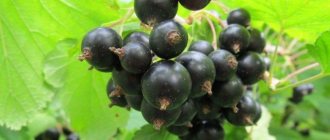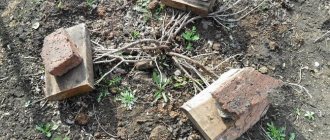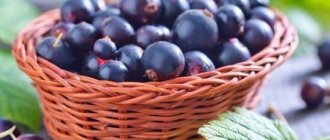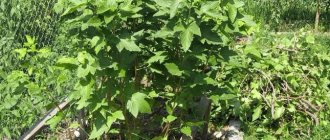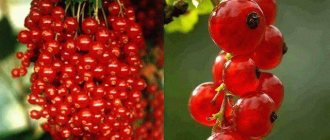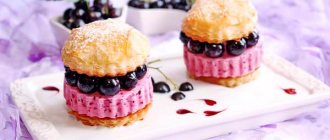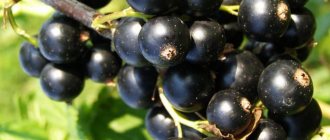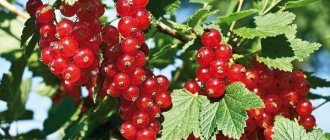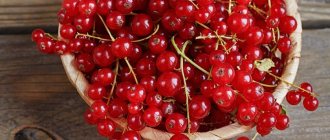Description of the currant variety “Gross”
Gross currant variety description. Gross is a worthy representative of the species, and, despite the existence of many varieties (and more than two hundred of them have already been bred), thanks to its remarkable qualities, it has found its place in many gardens and summer cottages.
Gross currants ripen thirty-five or forty days after flowering, depending on the weather, and they should be classified as early varieties.
The fruits are large and sweet, the clusters are eight or ten centimeters long, the berries are of the same size, which is important, they have a glossy skin of medium density and a dry peel.
Currants of the Gross variety are distinguished by a stable and rich harvest - up to four kilograms per bush.
The bush has an average growth vigor, but is quite spreading, with average density and foliage. The plant tolerates harsh winters, summer heat and is resistant to diseases.
All of these qualities are components of great success among gardeners. Along with this variety, quite often in our gardens you can find such varieties of black currant as Belorusskaya sweet, Dobrynya, Venus, Dachnitsa, Gulliver and Bagheera.
Characteristics of the variety
The Gross currant variety was “born” back in 1998. Despite the huge range of more modern hybrids and varieties, Gross remains one of the most popular crops and is successfully grown in a wide variety of volumes.
Black currants were bred at the Russian Breeding and Technological Institute. To obtain a new species, the famous Large currant was pollinated with pollen from such hybrids as Bredtorp and Khludovskaya. The resulting variety, Gross, is classified as a member of the Kryzhovnikov family.
Description of the variety Gross:
- the bushes are medium-sized and medium-leafed, but quite spreading;
- the thickness of the shoots is average, young branches are colored green, old ones are brown;
- there is no pubescence on the shoots;
- the shape of the leaves can be either five-lobed or three-lobed;
- The leaves are medium in size, matte green in color, with a small fluff on the back side;
- a characteristic feature of the Gross variety is wrinkled and even bulging leaves;
- The root system of black currant is very well developed, the length of old roots can be 150 cm or more;
- the inflorescences are bisexual, therefore the Gross culture is considered self-fertile;
- The flowers are large in size, pink in color, saucer-shaped;
- the length of each cluster with berries is 8-10 cm;
- the petioles on the racemes are of medium thickness and green;
- The shape of currant berries is round, the surface is glossy, the size of the fruit is large;
- the average weight of berries is 1.5 grams, there are fruits weighing 2.5 grams;
- the taste qualities of the Gross variety are excellent - the flesh is dense, the aroma is strong, the pleasant sweet-sour taste;
- The commercial qualities of black currant are good, all the berries are beautiful and of approximately the same size and shape;
- the berries are picked dry, so they do not drain and withstand transportation;
- The variety has a high yield - from 3 to 4 kg from each bush;
- The plant has a long lifespan - about 25 years;
- The peak yield occurs in the 3-4th year of fruiting, then the volumes gradually decrease;
- ripening dates are early - currant berries ripen in early July;
- from the moment of flowering to the ripeness of the fruit, it usually takes 35-40 days (the exact timing depends on weather conditions);
- Gross is considered a frost-resistant variety - this crop will withstand temperatures dropping to -35 degrees without shelter;
- The variety is not affected by summer heat or short drought;
- Currants have excellent immunity to anthracnose, powdery mildew and bud mite - the most dangerous diseases of the crop.
Read also: Blackberry Columbia Star: variety description, yield, reviews
Advantages and disadvantages
Reviews about Gross currants are the most positive: gardeners and summer residents love this crop and rarely replace it with more modern varieties. Growing this variety of black currant is beneficial both in summer cottages and on an industrial scale - Valovaya has a lot of strengths.
Advantages of domestic blackcurrant:
- high productivity;
- resistance to weather conditions;
- excellent frost resistance;
- immunity to the most common infections;
- good commercial quality;
- large berries;
- long growing season;
- early maturation;
- self-fertility;
- excellent taste and strong aroma.
The Russian variety has no major drawbacks. Some gardeners note a decrease in yield as the bush matures. As practice shows, the number of fruits at Valovaya decreases very slightly over the years and, all the same, the yield remains at a decent level.
Photo
Planting and care
Planting currants is a simple matter, but it has its own characteristics and they must be taken into account. First of all, take care of the variety of planting material; do not buy seedlings from random sellers.
Black currant has a useful feature : it tolerates light shading well, and this allows the gardener to compact the area without damaging existing plantings.
Gross currant is a medium-sized bush, but spreading, and this must be taken into account when planting; plants should be placed no closer than two meters from each other - this will allow for quality care of the currant.
The quality of the soil on the site is a factor that has a huge impact on the life of the plant, but the use of fertilizers will correct any situation. For one planting hole, a large bucket of humus, two handfuls of superphosphate, half a handful of any potassium salts and a shovel of wood ash are enough. All components are thoroughly mixed and poured into the planting hole.
The planting hole has dimensions of fifty by fifty centimeters and a depth of fifty centimeters; a side is placed along the edge of the planting hole to retain water during irrigation.
When planting, the plant is watered abundantly, and the soil is mulched with any auxiliary material, and in its absence, with dry soil. After planting, cut the seedling into two or three buds.
You can plant black currants in both spring and autumn.
With proper care, currants quickly take root and grow actively; the first test berries can be tasted already in the second year after planting.
The main requirements for care after planting, and in subsequent years, are weeding and watering as needed.
Fertilizing treated wisely; organic matter is applied once every three years, and mineral fertilizers can be applied annually, strictly following the recommendations.
Reproduction
Currant of the Gross variety is a self-fertile plant, and if you were able to plant only one bush, do not be upset, black currant reproduces well and very soon you will get the number of plants of this excellent variety that you need.
The Gross currant has a spreading bush , and if you press a low-lying branch to the soil, by the fall it will grow into a fully-fledged young plant. It is better to separate it from the mother plant in the spring, immediately before planting.
currant bushes have a feature that you need to remember if you skip loosening - branches lying on the ground begin to take root. To avoid this, many gardeners build a frame that supports the lower branches above the soil.
By the way, black currants not only get along well with red currants, but these berries can complement each other perfectly. Pay attention to such common varieties as Andreichenko, Natalie, Beloved and Marmeladnitsa.
Advantages and disadvantages
As a result of selection, scientists managed to obtain a variety that successfully combines positive qualities:
- winter hardiness;
- resistance to powdery mildew;
- one-dimensional berries;
- mid-early ripening;
- stable fruiting;
- simultaneous ripening of berries;
- good transportability;
- self-fertility;
- drought resistance;
- high yield.
Among the disadvantages it should be noted:
- too spreading bush;
- berries are more suitable for technical processing.
Berry composition
Sweet and sour berries contain vitamins and other useful substances:
- vitamin C – 175 mg (per 100 g);
- vitamin A;
- fruit acids – 2.3%;
- sugar – 7.2%;
- iron;
- potassium;
- pectin;
- anthocyanins.
The content of vitamins and biologically active substances in fruits depends on the characteristics of the variety and the growing conditions of the plant.
Application
Fragrant and healthy berries can be consumed raw and used to make preparations for the winter. They are subjected to the following types of processing:
- drying;
- freezing;
- boiling.
The leaves are added to tea to give it a pleasant aroma and saturate it with beneficial biologically active substances.
Read the link to see how the taste qualities of Rowada currants are assessed.
Medicinal properties
The leaves and berries of this useful plant have been used by healers since ancient times. They have medicinal properties:
- normalize metabolic processes;
- fight inflammation;
- have a beneficial effect on hematopoiesis;
- have a diuretic effect.
Blackcurrant ranks 3rd in vitamin C content after rose hips and citrus fruits. A handful of fresh berries, eaten daily, covers the daily requirement for vitamin C.
Drinks prepared with the addition of currant fruits are useful to drink for vitamin deficiencies, for recovery after illness, and for mental and physical overload. Recently, black currant fruit has been confirmed to have a positive effect on vision, similar to blueberries. This fact is associated with the high antioxidant activity of anthocyanins, which are present in large quantities in the berries of these plants.
Trimming
With proper care, a blackcurrant bush can live up to twenty-five years, and it comes down to proper pruning of the plant.
The first five years after planting, the bush is formed; each spring, three or four shoots of good quality are left; in the sixth year after planting, the oldest shoots must be removed, leaving approximately the same number of young shoots to replace them.
There is a gradual replacement of old shoots with young ones, and the yield does not fall, the quality of the fruit does not suffer - your bush is always young .
The Gross blackcurrant variety can be called ideal, it tolerates heat and cold well, is self-fertile, productive, resistant to disease, and the most important thing for which we try so hard is that this currant is very tasty. It’s definitely worth finding a corner on your site for this.
Reviews
Reviews from gardeners about the chokeberry variety Gross are extremely positive. Many people prefer to replace old varieties of currants on the site named after. Valued for its unpretentiousness in growth, drought and frost resistance, and ease of reproduction. Ideal for beginner gardeners.
Olga Viktorovna, Samara
Before choosing a currant variety for a summer cottage, I read many reviews from experienced gardeners. The currant variety Gross caught my attention. I still don’t regret my choice. Every year I collect up to 6 kilos of large, sugary and fragrant berries from a bush. For 3 years the bushes have never gotten sick, which is especially pleasing. The only thing is that you have to constantly fight against the attacks of aphids.
Anastasia, Astrakhan
On the advice of a neighbor, I planted currants at the dacha. The seedlings took root successfully, despite the cool weather. The next year, the first harvest was harvested, which surprised me with its abundance and taste. The berries are the same size, no substandard ones. They make fragrant dessert preserves for the winter.
Diseases and pests
The Gross variety is resistant to diseases, but to say that it is also resistant to pests is somehow naive. You will have to fight the pests yourself. If you notice buds that are too large in comparison with the others, this is a bud mite.
Branches with a large number of affected buds should be cut off and burned, and the bushes should be sprayed with Neoron or Akarin before flowering and after flowering.
The larvae of the moth infest the fruits and, at the slightest danger, fall to the soil under the bush; the insect pupa overwinters in the soil. When fighting it, autumn digging and spraying with shag infusion before flowering is necessary.
If you notice twisted shoots on the bushes with small and pale foliage, this is currant glass, it feeds on the core of the shoot. Diseased shoots should be cut off and burned, and the plants should be treated with any insecticide after flowering.
And of course, the ubiquitous aphid harms the plant; no matter how much you weed it, the ants will spread new ones, and so on until you kill the ants themselves. It is necessary to destroy the anthills on the site and pour boiling water over them.
On our website you can read in detail articles about the most common diseases of garden crops: anthracnose, chlorosis, oidium and mildew, bacteriosis, https://selo.guru/ptitsa/bolezni-p/gribkovye/parsha.html and rust, bacterial cancer and bacterial burn, rubella.


